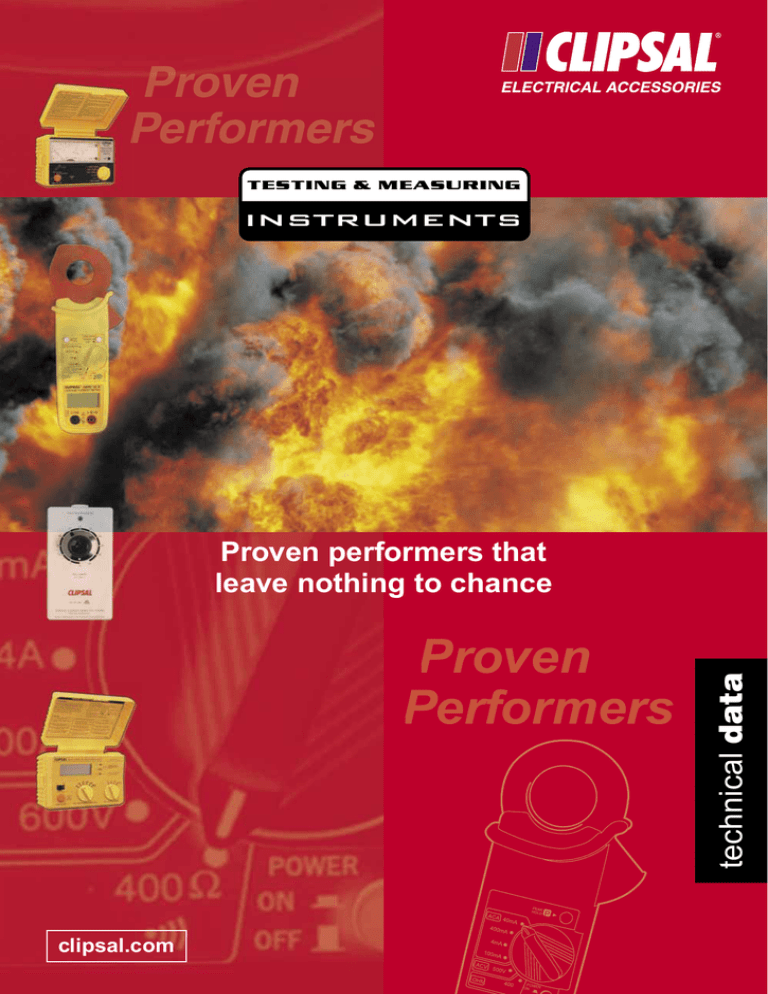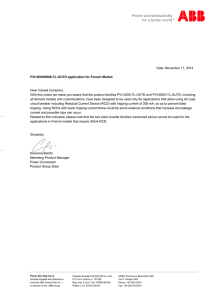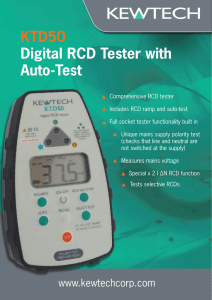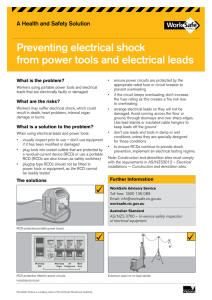
Proven
Performers
clipsal.com
technical data
Proven performers that
leave nothing to chance
page
2
4
CONTENTS
Introduction
page
491 Insulation and Continuity Tester
5
489D Universal Clamp Meter with Residual Current Measurement
6
484 Earth Loop Tester
6
486AD10/20 486AD32/50 Three Phase Test Adaptors - suit 486D
7
486CD Microprocessor Controlled RCD Tester
8
486D Digital Read-Out RCD Tester
9
488 RCD Sensitivity Tester
10
‘Electrical Contractors’ on site fault finding guide
12
‘Home Owners’ fault finding guide
13
ITACS Calibration Service
SELF REGULATION MEANS PUTTING YOUR
One of the most significant changes to
the Australian and New Zealand electrical
industry is the introduction of self testing
of electrical installations.
While some Australian states are moving
in this direction faster than others, it is
expected to be only a matter of time
before self regulation is adopted
Australia wide.
In New Zealand, self regulation is already
in place in all regions.
With self regulation putting the
responsibility of correctly wiring and
testing electrical installations on to you,
the electrical contractor, it’s vital that you
use only the highest quality testing and
measuring instruments available.
Clipsal pioneered the development and
technology of RCDs in Australia in the
1970s and since that time has been
Australia’s leader in this field.
With such extensive expertise in this
area, you can also rely on Clipsal for
Testing and Measuring Instruments that
accurately measure and confirm the
performance of RCDs.
Clipsal offers the following types of RCD
Testing and Measuring Instruments:
The top of the range 486CD and highly
respected 486D RCD Testers provide
digital read-outs of the tripping time of
RCDs under test conditions, while the
488 RCD Sensitivity Tester allows for
the test injection of predetermined
leakage current.
TRUST IN THE MOST PRECISE INSTRUMENTS
Also included are the 491, a 1000V
Insulation and Continuity Tester, and
the 489D, a Digital Universal Clamp
Meter which can also be used to read
residual currents.
Manufactured to exacting standards,
Clipsal Testing and Measuring Instruments
include many features that ensure
accuracy, reliability and ease of use.
Calibrating Your Test Equipment
In addition to using the most reliable
test instruments available, recent legislative
changes in some Australian states
make it essential that the calibration of
your instruments is maintained on a
regular basis.
International Testing and Certification
Services (ITACS), a NATA registered
test laboratory, provides a Calibration
Service that calibrates your instruments
and provides a Calibration Report in
the form required and accepted by the
Regulatory Authorities.
ITACS offers this service to the electrical
industry throughout Australia. Please refer
to page 15 for more information.
Calibrating Report
In line with moves towards mandatory
testing and calibration of test instruments,
all Clipsal Test Instruments are now
available with an ITACS Calibration Report
for a small additional charge. Add “C” to
existing Catalogue Number.
491 INSULATION AND CONTINUITY TESTER
491
INSULATION AND
CONTINUITY TESTER
Test probe
The primary test instrument for any
electrical testing and measuring is an
Insulation and Continuity Tester, and
the Clipsal 491 is perfect for these
applications.
Earth probe
The 491 has three insulation resistance
scales and can test at up to 1000V d.c.
in line with the requirements of AS 3000
Clause 1.5.2.1.
Easy to read expanded
analogue scale
Two continuity ranges and a battery check
facility are also provided.
Range switch
Test button
Audible and visual live
circuit warning
Light switch
Power on indication
lamp
The 491 incorporates a large, easy to
read, analogue display, with a back lit
function for testing in dimly lit areas. The
lock-on feature of the ‘press to test’ button
allows hands free operation.
Ohms zero setting
Insulation and Continuity Testers are not
designed to be used on energised circuits,
but the 491 has several safety features
that help protect the unit. On the insulation
resistance ranges, these include a visual
and audible warning to indicate that the
leads have been connected to a
live circuit.
Accuracy can be maintained with
the movement zero adjustment. The
zero ohms adjustment can be used
to offset any lead resistance in the
measurement circuit.
The continuity ranges are fuse protected,
with a spare fuse included.
Features
The Clipsal 491 is supplied with
batteries, test leads and pouch,
shoulder strap and a robust carry case.
• Easy to read expanded analogue scale
• Back lit function
• Robust impact resistant carry
case/housing
• Audible and visual live circuit warning
• Front panel ohms zero adjustment
• Fuse protected in continuity ranges
• Lock on feature for hands free
operation (including back light).
• Supplied with shoulder strap, test
leads, pouch, batteries and spare fuse.
• 3 insulation test voltages
• 2 continuity ranges
Specifications
Insulation Test Voltages
Test Voltage
250V
500V
Measuring Range
0 - 100 Megohms
0 - 200 Megohms
0 - 400 Megohms
Mid Scale Value
Maximum Output Voltage
On Open Circuit
Minimum Output Voltage
1 Megohm
2 Megohms
4 Megohms
250V d.c. + 10%
500V d.c. + 10%
1000V d.c. + 10%
500V d.c. (@ 0.5 Megohms)
1000V d.c. (@ 1 Megohm)
250V d.c. (@ 0.25 Megohms)
Output Short Circuit Current
Approximately 1.3mA across range
Output Current
1mA d.c. min @0.25 Megohms
Accuracy
± 5% of value
Standards
IEC61010-1: 1995 Safety requirements for electrical equipment for measurement, control, and laboratory
- Overvoltage category 3, working voltage 1000V pollution Degree 2.
@ 0.05 - 10 Megohms
1mA d.c. min.@ 0.5 Megohms
1mA d.c. min.@ 1 Megohm
+/-5% of value
± 5% of value
@ 0.2 - 40 Megohms
@ 0.1 - 20 Megohms
± 7% of scale length at ranges other than those listed.
Continuity Test Ranges
4
1000V
Measuring Ranges
0 - 2 Ohms and 0 - 20 Ohms
Output Voltage On Open Circuit
4 - 9V d.c.
Output Short Circuit Current
200mA min.
Accuracy
± 3% of scale
Power Supply
6 x 1.5V batteries - type R-6, AA or equivalent - GP15A GP Batteries
Typical Number of Tests
(Battery Life)
250V range 2,000 times approx.
500V range 1,300 times approx.
1000V range 350 times approx.
60V a.c./d.c. to 600V a.c./d.c.
Operating Voltage for
Warning Lamp and Buzzer
Dimensions
170 (L) x 115 (W) x 85 (D)mm approx.
Total Weight
1kg
489D UNIVERSAL CLAMP METER WITH RESIDUAL CURRENT MEASUREMENT
489D
UNIVERSAL CLAMP
METER WITH RESIDUAL
CURRENT MEASUREMENT
Transformer jaws
Transformer jaw trigger
A recent inclusion in our range of testing and
measuring instruments is the 489D Universal
Clamp Meter, the ideal every day instrument
for anyone involved in the electrical industry.
Peak hold button
Range switch knob
Power on/off switch
Features include current ranges from 40mA
to 100 Amp., AC voltage capacity up to 500
volts and a 400 ohm resistance range is a
buzzer which sounds when resistance is less
than 50 ohms.
LCD screen
Test lead sockets
The LCD screen displays measurement
unit and functions, as well as overload, low
battery warning and peak hold ‘on’ indicators.
The 489D can clamp conductors up to
35mm in diameter.
Also included is a peak hold facility for taking
readings in awkward situations, a swivel wrist
strap, test leads and a sturdy carry case.
While its most popular function is as a
general purpose meter, the Clipsal 489D
is particularly suitable for detecting and
locating earth leakage faults in installations
and appliances.
By clamping both the Active and
Neutral conductors, the meter displays
the residual current (or leakage current)
of the circuit.
The 40mA scale displays currents to a
resolution of 0.1 milliamps and is ideally
suited to this purpose.
The 489D is supplied with a Clipsal
461 Appliance Test Adaptor for testing
appliances for leakage current.
Features
• Four AC current ranges
• Voltage measurement up to 500Va.c
• 400 ohm resistance range with additional
buzzer indication below 50 ohms
• Peak Hold facility for awkward situations
• Swivel wrist band
• Suitable for cables up to 35mm in diameter
• Supplied with a Clipsal 461 Appliance
Test adaptor for appliance testing
• Includes test leads and sturdy carry case.
Specifications
AC Current Range
Range
Resolution
Overload Protection
40mA
0.01mA
1A
400mA
0.1mA
10A
4A
1mA
100A
100A
0.1A
500A
Accuracy
40Hz - 1kHz
± (1.5% + 2 digits)
Note: The 40mA range is very sensitive and may not give a zero reading with no
current flowing in this circuit. This is normal.
AC Voltage Range
Range
500V
Resolution
1 Volt
Accuracy - 50Hz - 500Hz
± (1.5% + 5 digits)
Input Impedance
10 Megohms
Overload Protection
1000V d.c.
750V a.c.
Resistance Range
Range
Resolution
Overload Protection
400 Ohm
0.1 Ohm
500V a.c. or d.c.
Accuracy
± (1.2% + 3 digits)
Maximum Open Voltage
3.3 Volts
Audible Indication
Display
Buzzer sounds if resistance is less than 50 Ohms
3¾ digit LCD display with decimal point, measurement units, overload, low battery and peak hold
‘on’ indicators.
2.5 times per second
Sampling Time
Operating Temperature
Power Supply
Battery Life
-10°C to +50°C (less than 80% humidity)
9V d.c. G1604A or equivalent
200 hrs
Dimensions
221 (L) x 62 (W) x 35 (D)mm
Weight
342g
Accessories
Carry case, test lead set, battery and Clipsal Appliance Test Adaptor
Standards
IEC61010-1: 1995 Safety requirements for electrical equipment for measurement, control, and laboratory
- Overvoltage category 3, 600Vac pollution Degree 2, Class 2.
5
484D EARTH LOOP TESTER
484D
EARTH LOOP TESTER
486AD THREE PHASE TEST ADAPTORS
The Clipsal Earth Loop Tester makes it
easy to confirm fault loop impedance as
required by AS/NZS3000.2000. (Clause
1.7.4.3.3). Simply plug it in and press the
button. It offers precise readings without
calculations or guesswork.
Press test button
Three neon check for
correct wiring
Rotary switch to set loop
impedance ranges
Features
• Neon indicators confirm
circuit conditions
• Precise and easy to read
digital readout
• 3 test ranges
• Test button with lock down facility
for hands free testing
• Resolution down to 0.01Ω
• Automatic lock out if test
register overheats
• Robust construction
• Carry strap
Specifications
Loop Impedance Accuracy
20/200/2000Ω
± 2% ± 2dgt at 1Ω on 20Ω range
Lowest Resolution
0.01Ω
AC Test Current
25A nominal at 20Ω range
AC Test Period
20ms
Loop Impedance Ranges
Operating Voltage
220V ± 10%, 50Hz
Withstand Voltage
3000V AC for 1 minute
Fuse Protection
HRC Ceramic fuses
Dimensions
175(L) x 115(W) x 86(D)mm
Weight
440g approx.
Accessories
Test Lead with plug Pouch for test leads.
Shoulder Pad Instruction Manual.
Standards
IEC61010-1: 1995 Safety requirements for electrical equipment for measurement, control,
and laboratory Overvoltage category 3, working voltage 300V pollution Degree 2.
486AD10/20 486AD32/50
THREE PHASE TEST ADAPTORS
- SUIT 486D TESTERS
With RCDs now common in the workplace,
testing is essential to maintain a safe
working environment. The Three Phase
Adaptor allows testing of three phase
RCD outlets without disconnection or
alterations. It is designed to be used with
the Clipsal 486D tester (not suitable for
the 486CD).
To use, simply plug the adaptor into the
outlet to be tested. Then plug the 486D
into the adaptor. This is much faster and
safer than using probes. A selector switch
also allows testing for fault operation on
each individual phase.
Features
486AD10/20
6
• Adaptor for 10 and 20A three
phase outlets
Plug in 486D RCD Tester
Rotary switch to set Phase to test
486AD32/50
• Adaptor for 32, 40 and 50A three
phase outlets
Plug in adaptor into fixed outlet
486CD MICROPROCESSOR CONTROLLED RCD TESTER
486CD
MICROPROCESSOR
CONTROLLED
RCD TESTER
Press test button with lock
down feature
The 486CD is one of the most
sophisticated and accurate instruments
available for measuring the tripping time
of RCDs.
Rotary switch to select RCD
‘Test Current’ ranges
Three neon lamps check for
correct wiring
The secret to this accuracy is the
microprocessor control.
Digital read-out tripping time
Unlike most other testing instruments, the
test currents of the 486CD are not affected
by variations in the supply voltage.
Rotary switch to multiply basic
RCD ‘Test Current’ ranges
Zero cross circuitry selector switch
The constant current circuitry ensures
accurate and consistent measurements,
even when the supply voltage fluctuates
by up to ± 10%.
The other key difference between the
Clipsal 486CD and most other instruments
is the DC test facility.
With the widespread use of electronic
equipment, many faults that occur in
commercial and industrial installations
have a DC component.
Different types of RCDs perform
differently under these circumstances,
and it is essential, particularly in
specialised environments, such as patient
treatment areas and laboratories, that
the performance of the RCD under DC
conditions can be accurately assessed.
Specifications
Trip Current Settings
10, 20, 30, 100, 500 & 1000mA
Test Functions
x½, x1, *x5, d.c.
Fault Trip Time
2000ms (200ms at x5)
Operating Voltage
220 - 260V
Maximum Input Voltage
370V peak
Power Consumption
Less than 2W
A.C. Current Test (accuracy)
x½
x1
x5
+0, -5% of test current at 240V
± 2.5% of test current at 240V
D.C. Current Test (pulsed)
Other features include six trip current
settings, a selector switch for testing
either the positive or negative half cycle,
indicator lights for checking polarity, an
easy to read LCD display, and a data hold
facility for hands free operation.
The 486 CD comes in a robust carry case
and includes test leads.
Features
• Microprocessor controlled for highest
accuracy and reliability
• D.C. test facility
• Tripping ranges from 10mA to 1000mA
• Zero cross circuitry permits testing
starting either half cycle
• Easy to read LCD display
• Measures tripping times up
to 2000ms (200ms at x5)
• Data hold facility for hands
free operation
• Indicators for checking wiring
• Robust carry case
• Test plug and 1.5 metre lead
Test Current (half wave)
Half wave of 1.4 x test current ± 2.5% of test
current at 240V
DC Bias Current
± 6mA ± 3% at 240V
Trip Time
Less than ± (0.6% ± 2 digits of reading)
Display Hold Time
Greater than 10s on loss of power
Over Range Indication
‘1’ or ‘ or ’ in display
Over Temperature Indication
‘1’ and ‘ ’ in display
Operating Temperature Range
0°C - 40°C
Storage Temperature Range
-20°C - + 60°C
Operating Humidity
85% maximum
Storage Humidity
85% maximum
Dimensions
175 (L) x 115 (W) x 85.7 (D)mm approx
Weight
440g approx.
Accessories
Test plug and 1.5 metre lead.
Carry pouch for leads
* Does not include 1000mA range.
Standards
IEC61010-1: 1995 Safety requirements for electrical equipment for measurement control, and
laboratory. Overvoltage category 3, working voltage 300V pollution Degree 2.
7
486D DIGITAL READ-OUT RCD TESTER
486D
DIGITAL READ-OUT
RCD TESTER
An economical alternative to the 486CD
for every day installations is the 486D.
Digital read-out tripping time
This unit incorporates six trip current
settings, a selector switch for testing
either the positive or negative half cycle,
indicator lights for checking polarity, an
easy to read LCD display, and a data
hold facility for hands free operation.
Correct polarity indicators
Test Indicators
Rotary switch to select RCD
‘Test Current’ ranges
The 486D is supplied in a robust carry
case with a test plug and lead.
Rotary switch to multiply basic
RCD ‘Test Current’ ranges
‘Press to Test’ button
Features
• Tripping ranges from 10mA to 1000mA
• Zero crossing circuitry permits testing
on either half cycle
• Easy to read LCD display
• Measures tripping times up to 200ms
• Data hold facility for hands
free operation
• Indicators for checking wiring
• Test plug with 1.5 metre lead
• Robust carry case
Zero cross circuitry
selector switch
Specifications
Trip Current Settings
5, 10, 30, 100, 300 & 500mA
Test Current
No Trip Test
Trip Test
Fast Trip Test
Fault Trip Time
50% of RCD trip current selected
100% of RCD trip current selected
250mA regardless of RCD trip current selected
2000ms (40ms for fast trip)
Operational Voltage
240V a.c. ± 10% 50/60Hz
Accuracy
Test Current
Test Current Duration
With Limiter
Trip Time
± 3% at 240V a.c. ± 0%
2000ms ± 5% for trip and no trip tests
40ms ± 5% for fast trip test
± (2% reading + 3 digits)
Dimensions
140 (L) x 90 (W) x 20 (D) mm
Operating Temperature Range
0°C - 40°C
350g approx.
Weight
Accessories
Included
Optional
Test plug with 1.5 metre lead. Carrying case. Instructional manual.
Kit with 1.5m lead and alligator clips for direct connection to breaker terminals, etc.
(Cat. No. 486LK).
Note:
If testing delay action breakers on the 300mA or 500mA ranges, it is advisable to allow a cooling time of approximately 20 seconds between tests.
8
488
RCD SENSITIVITY TESTER
While the 486CD and 486D test that
RCDs perform to the Standard, the
488, with its ability to inject a range
of predetermined leakages, can be a
valuable tool when fault finding in
RCD circuits.
488 RCD SENSITIVITY TESTER
Test in Progress indicator
Simply plug the 488 into the circuit under
test, set the dial to the lowest current
setting and switch on the outlet.
Rotary switch to select
RCD test ranges
Every two seconds the 488 will inject
pulses of the selected leakage current
to earth, indicated by the neon.
The leakage current setting can be
stepped up between pulses until the
RCD trips. The setting, at this point,
is the nominal sensitivity of the
particular circuit.
The RCD itself can then be tested in the
same way with the circuit disconnected.
If the sensitivity reading of the RCD
alone is higher than the result obtained
from the circuit, it indicates that there
is an active to earth leakage path in
the circuit or in an appliance connected
during the test.
If the sensitivity reading of the RCD
alone is lower than the result obtained
from the circuit, it may indicate that there
is a neutral to earth bond in the circuit
or in an appliance connected during the
test.
Specifications
Operating Voltage
Nominal Leakage Current
*Settings at 240V
Duration of Leakage Current Pulse
240V a.c ± 20% 50/60Hz
6, 9, 12, 15, 18, 21, 24, 27, 30, 33, 36 & 40mA
Time Between Leakage Current Pulses
Between 1 and 3 seconds
Dimensions
155 (L) x 81 (W) x 72 (H) mm
Test Lead
1 metre lead with rewireable 3 pin plug
Between 100 and 400ms
* Leakage currents will vary in proportion to the Operating Voltage.
The earth path can then be located using
a Clipsal 489D Universal Clamp Tester
or 491 Insulation and Continuity Tester.
Note:
AS 3190 requires factory settings to be
between 15mA and 30mA for a 30mA
device. Clipsal 30mA RCDs are typically
set to activate between 20mA and 25mA.
Features
•
•
•
•
Twelve nominal leakage settings
Pulsed leakage injection
‘Test in Progress’ indicator
Test plug and one metre lead.
9
ELECTRICIANS’/CONTRACTORS ON SITE FAULT FINDING GUIDE
RCD trips
ELECTRICIANS’ FAULT FINDING GUIDE
Reset RCD
RCD holds in?
Unplug all appliances
NO
YES
Reset RCD
Perform press to
test function to
check operation
NO
RCD holds in?
YES
Trip may have been
caused by a fault in an
appliance or by momentary
electrical disturbances in
power supply network.
Bridge and Clamp test
(RCD in off position).
See notes 1& 2
Connect known
good appliance
NO
Is reading equal to
100% of load current?
NO
Is reading approx equal
to 50% of load current?
YES
Neutral and earth
swapped at connections
or neutral returning
via alternate circuit
Neutral to earth fault,
nail through cable or
bridged terminals
Clear fault for a
reading below 5mA
Clear fault for a
reading below 5mA
Remove bridge
10
YES
Remove bridge
Reset RCD
Reset RCD
Perform press to
test function to
check operation
Perform press to test
function to check
operation
Remember to test regularly
When you arrive at a customer’s house,
talk to them and find out what they were
doing when the RCD tripped.
NOTE 1: Bridging of combination RCDs
with overcurrent protection, negates
that function and may result in fusing
the main fuse with faulty wiring. Note
that in these instances, fault currents
could be significantly higher and suitable
precautions should be taken.
ELECTRICIANS’ FAULT FINDING GUIDE
RCDs should be tested monthly by operating their inbuilt test button. You should remind the householder of this.
NOTE 2: Under no circumstances should
the press to test function be utilised while
an RCD is bridged.
NOTE 3: Insulation breakdown could be
alternatively identified by the Clipsal 491
Insulation Tester.
Bridge and Clamp test
(RCD in off position).
See notes 1& 2
Faulty RCD
most likely
replace RCD.
Is reading above
trip current level?
NO
YES
Connect each
appliance one
at a time in turn
Are all readings
below 5mA?
NO
YES
Faulty appliance likely.
Test each appliance, eg. using
489D and Appliance Tester.
Use unprotected circuit or
bridged RCD. Remove or
repair faulty appliance.
YES
Plug in all
appliances
Clamp test
each protested
circuit in turn
Is reading
above 5mA?
YES
Is more than one
circuit protected
by RCD?
NO
is any reading
above 5mA?
Insulation breakdown
or contamination in
circuit connections.
See note 3.
YES
NO
NO
Clear fault for a
reading below 5mA
Remove bridge
Remove bridge
Reset RCD
Perform press to
test function to
check operation
If none of the individual circuits
or appliances have leakage
in excess of 5mA, circuits
or appliances should be
separated and protected by
more than one RCD.
11
Reset RCD
Perform press to
test function to
check operation
HOME OWNERS’ FAULT FINDING GUIDE
HOME OWNERS’ FAULT FINDING GUIDE
When you receive a call from a
customer, you might be able to talk the
customer through isolating potentially
faulty appliances.
Here is a general guide that can
be used when the Clipsal RCD is
switchboard mounted or built into a
power point.
Doing this enables your customer
to have power quickly restored and
prevents unnecessary call outs.
The same procedure generally
applies to both.
Trip may have been caused by
a fault in an appliance. Keep a
note of the appliances being
used and the times when the
trips occur. This infor mation
will help the electrician if one is
needed to check the installation.
Momentary electrical disturbances
can also cause an isolated trip.
RCD trips
Reset RCD
RCD holds
in?
RCD trips
YES
NO
Press Start
button
Unplug all
appliances
Reconnect and switch on one
appliance at a time in turn
Reset RCD
Remove faulty
appliance if RCD trips
RCD trips
Reset RCD
RCD stays
on?
Reset RCD
YES
NO
Reconnect other
appliances
RCD trips
RCD
stays on?
Phone
electrician
Faulty wiring
or RCD?
Faulty RCD or installation likely.
NO
YES
RCD trips
Press Start
button
RCD trips
RCD stays on
12
Trip was possibly caused by small
amounts of accumulated leakage
from a number of appliances into
other circuits or have another
power circuit installed.
Have faulty appliances tested and
repaired. Steam irons, fry pans,
toasters, etc. may need attention.
For Measuring the Accuracy
of Electrical Instrument
Established in 1980, International
Testing and Certification Services
(ITACS) is a NATA Registered
Electrotechnical Testing facility.
Third party assessment by NATA
has established the laboratory’s
independence from any manufacturers
with regard to impartiality and technical
competence of testing.
The laboratory’s compliance with ISO
Guide 25 (SA HB 18.25) General
Requirements for the competence of
Calibration and Testing Laboratories,
also ensures against improper
influences on results of examinations
and tests.
ISO Guide 25 incorporates the
requirements of quality management
system in accordance with ISO 9002.
ITACS provides an electrical instrument
calibration service for electrical workers
and contractors.
Laboratory staff comprise of engineers
and technicians who have many years of
experience in calibration.
Self regulation has led to the introduction
of a new audit process for electrical
workers. During this audit, it is necessary
to produce evidence that electrical
instruments have been calibrated and
the accuracy of meter reading has been
checked.
Quality Assurance
The calibration services and test reports
we provide have results traceable to
National Standards in accord with some
States legislation. In addition, they satisfy
the calibration and traceability required by
AS 9000 series for Quality Assurance.
ITACS Calibration Services provides:
• Calibration of electrical instruments
used by electricians, covering most
popular brands, including
- Multimeters (digital and analogue)
- Insulation Testers
- Continuity Testers
- RCD Testers
- Clamp Meters (digital and analogue)
- Other instruments on request
• ITACS does not provide an instrument
repair service. A nominal fee is
charged for instruments found during
the calibration process not to be in
proper working order.
Calibration Capabilities
d.c. voltmeters
0 - 1000V
a.c. voltmeters
0 - 1000V (50Hz - 20kHz)
d.c. ammeters
0 - 20A
20 - 1000A*
a.c. ammeters
0 - 20A (50Hz - 5kHz)
20 - 1000A* (50kHz)
Ohmeters
0 - 400MΩ and applied voltage up to 1000V
(inc. Megohmmeters)
Time measuring
Pulseband 0.30ms to 1999.9ms
*multiple turns
ITACS
International Testing and
Certification Services
NATA REG. 1700
PO Box, Hindmarsh
South Australia, 5007
4-6 Second Street, Bowden,
South Australia, 5007
Telephone (08) 8346 8680
Facsimile (08) 8346 7072
Toll Free 1800 675 473
E-mail itacs@itacslab.com
13
NOTES
14
NOTES
15
NOTES
16
Product of Clipsal Australia Pty Ltd
ABN 27 007 873 529
Head Office
12 Park Terrace, Bowden
South Australia 5007
Telephone (08) 8269 0511
Facsimile (08) 8340 1724
Internet clipsal.com
E-Mail plugin@clipsal.com.au
Offices in all States
NSW Sydney
Albury
(02) 9794 9200
(02) 6041 2377
VIC
Melbourne
Country Areas
(03) 9207 3200
1800 653 893
QLD
Brisbane
Townsville
(07) 3244 7444
(07) 4729 3333
SA
Adelaide
(08) 8268 0400
WA
Perth
(08) 9442 4444
TAS
Launceston
(03) 6343 5900
NT
Darwin
(08) 8947 0278
Area Representatives
NSW Albury
Central Coast
Coffs Harbour
Dubbo
Newcastle
ACT
Canberra
Canberra/Goulburn
Canberra/Yass
0419 238 824
0418 164 070
0419 847 732
VIC
Bendigo
Geelong
Gippsland
Western Victoria
0418 570 213
0418 527 233
0418 512 680
0419 380 444
Cairns
Mackay
Maryborough
Northern Rivers
Rockhampton
Sunshine Coast
Toowoomba
Townsville
0418 773 254
0418 752 134
0418 664 338
0418 768 902
0419 869 752
0418 711 786
0418 726 394
0418 180 372
QLD
WA
SA
Bunbury
0418 931 684
Kalgoorlie &
0417 928 981
Eastern Gold Fields
Karratha
0418 937 249
Riverland/Mildura/
Broken Hill
CLIPADV 6960
0418 596 145
International Enquiries
International Sales and Marketing
Telephone + 61 8 8269 0587
Facsimile + 61 8 8340 7350
E-Mail export@clipsal.com.au
New Zealand
Clipsal Industries (NZ) Ltd
Telephone (09) 576 3403
Facsimile (09) 576 1015
E-Mail headoffice@clipsal.co.nz
Customer Service
Free Fax (0508) 250 305
Auckland/Mobile Phone (09) 572 0014
Free Phone (0508) CLIPSAL
2547725
You can find this brochure and many
others online in PDF format at:
clipsal.com
Follow the links off the home page
or access the following page directly:
clipsal.com/wat_lib_pdf.cfm
clipsal.com
Clipsal Australia Pty Ltd reserves the right to change
specifications, modify designs and discontinue items
without incurring obligation and whilst every effort is
made to ensure that descriptions, specifications and
other information in this catalogue are correct, no
warranty is given in respect thereof and the company
shall not be liable for any error therein.
© Copyright Clipsal Australia Pty Ltd 2004.
All rights reserved.
This material is copyright under Australian and
international laws. Except as permitted under the
relevant law, no part of this work may be reproduced
by any process without prior written permission of
and acknowledgement to Clipsal Australia Pty Ltd.
C1-001
(02) 6041 2377
0418 430 361
0418 653 183
0418 822 564
0407 298 792
0418 434 169
0418 686 040
South West Sydney 0419 868 353
Tamworth
0417 714 339
Wagga Wagga
0418 578 903
Wollongong
0418 423 581
O/N 262-072 FEB 05/02




